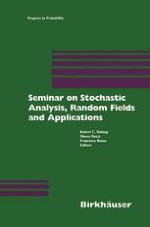1999 | Book
Seminar on Stochastic Analysis, Random Fields and Applications
Centro Stefano Franscini, Ascona, September 1996
Editors: Robert C. Dalang, Marco Dozzi, Francesco Russo
Publisher: Birkhäuser Basel
Book Series : Progress in Probability
Included in: Professional Book Archive
